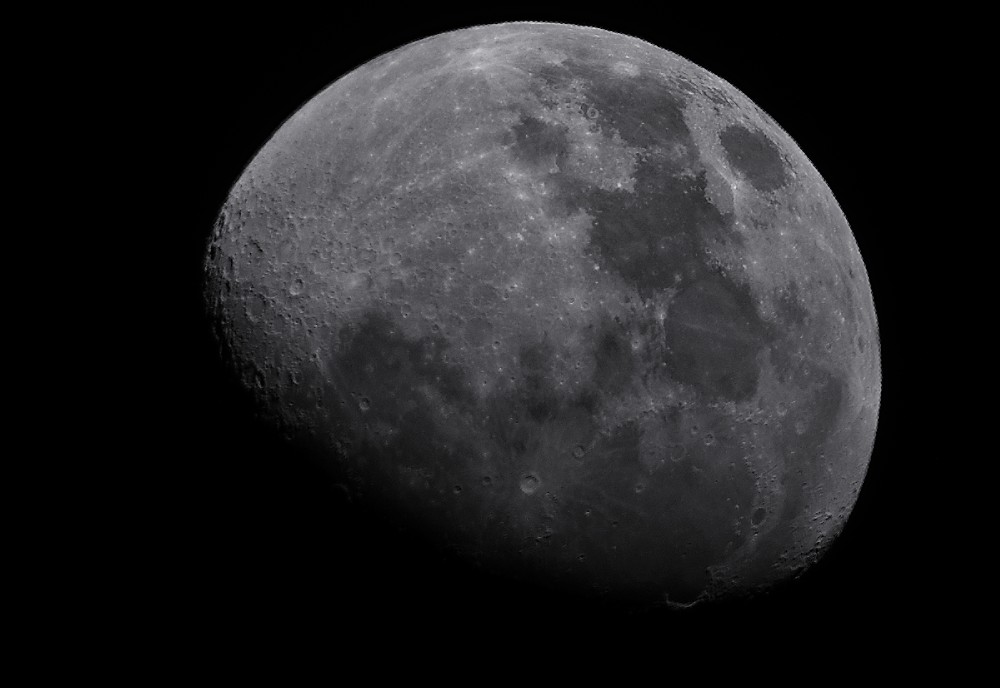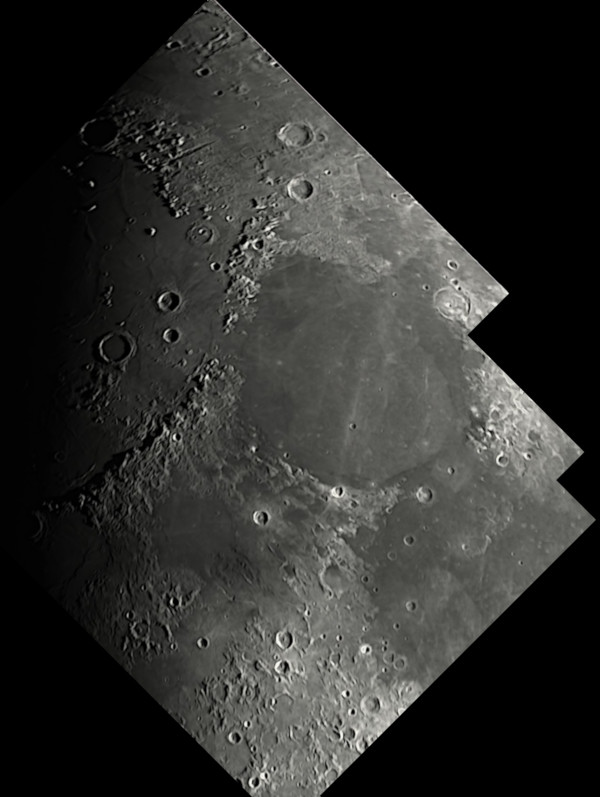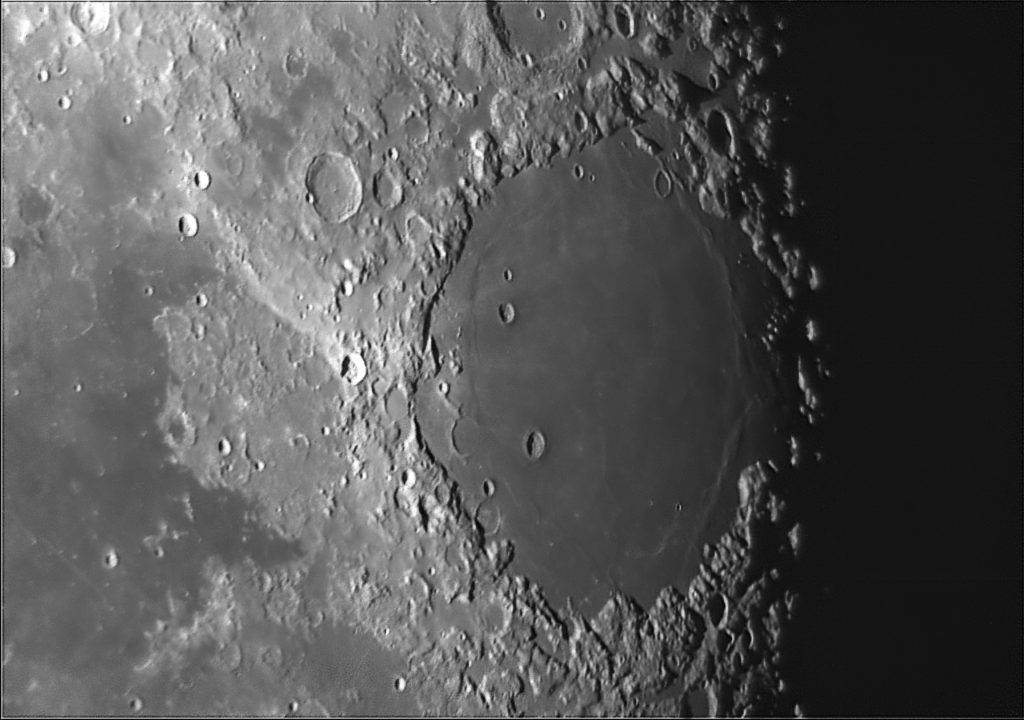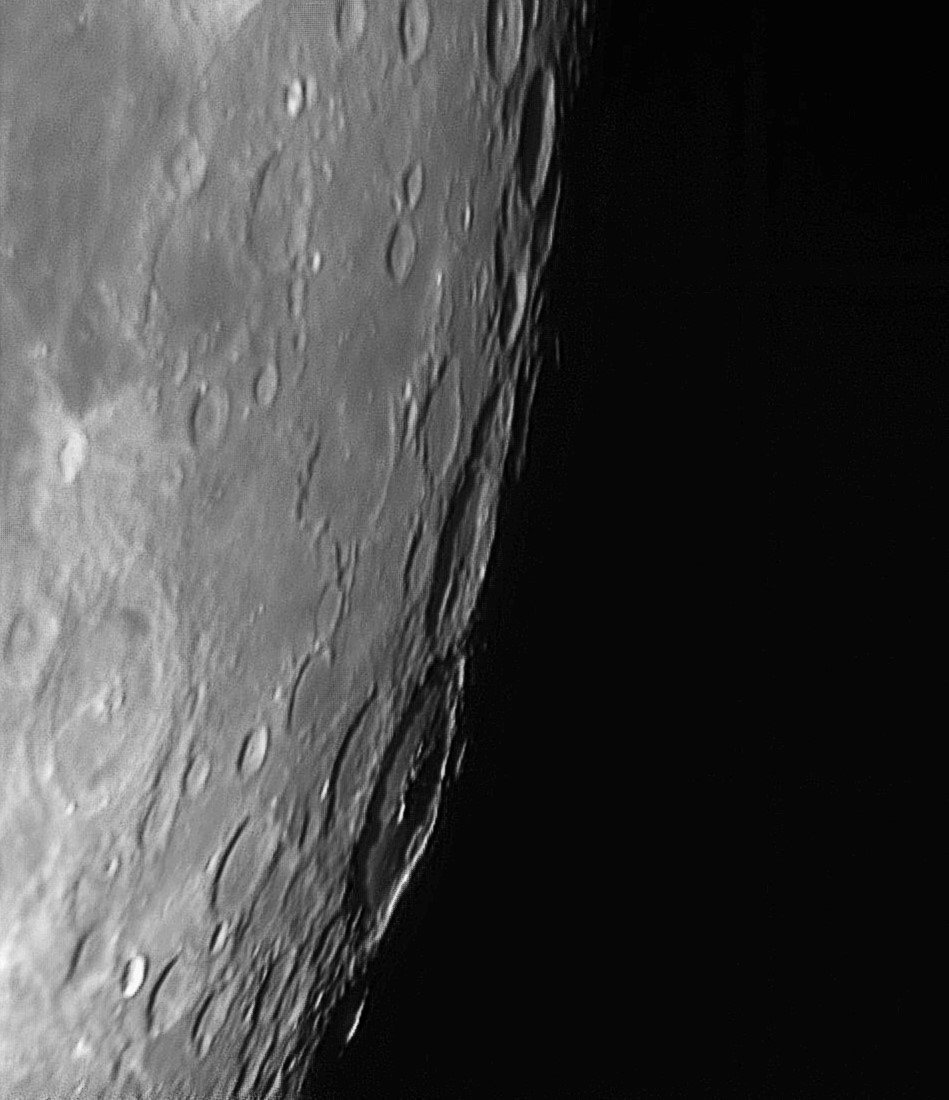Moon

10.1″ f/4.5, Mallincam DS432cTEC
Exposure = 0.878 msec, Frames = 1, Gain = 5 of 250
January 24, 2021 – 01:16 UTC
Phase is 3 days past first quarter. Copernicus is the prominent crater lower center; sunrise on the mountains of Sinus Iridum lower right near the terminator.
North at 4 o’clock, East at 7 o’clock
Mare Serenitatis and Apennines mountains

10.1″ f/4.5, Mallincam DS432cTEC with 2.5x Barlow
November 12, 2021
Moon is waxing gibbous, 1 day past first quarter. Prominent center-left is Mare Imbrium with the triad of craters Archimedes, Aristillus, and Autolycus (in descending order of size). Center-right is Mare Serenitatis with the large craters Aristoteles and Eudoxus above it. Standing in fantastic relief on the southern edge of Mare Imbrium is the Apennines mountain range; the Hadley Rille region where Apollo 15 landed is at the north end of the range. A thin gash on the top edge of Mare Imbrium is the Alpine Valley; its dark floor is approximately 10 km across at its widest.
North at 12 o’clock, East at 9 o’clock
Mare Crisium

10.1″ f/4.5, Mallincam DS432cTEC with 5x Barlow
Exposure = 3 msec, Gain = 39 of 250
August 14, 2022 04:16 UTC
Mare Crisium in relief, 1.5 days past full moon. As the sun sets in this region, the shadows advance from west to east revealing an incredible amount of detail in the nearby mountains and craters. Near the western limb of Mare Crisium is a neat collection of eight or so bright dots that are mountains rising from the flat basin of the mare. A little east of that is an interesting ridge that runs all along the western side of the mare from north to south that isn’t obvious when the lighting is different; Lunar QuickMap (Lunar Reconnaissance Orbiter Camera data) identifies this as wrinkle ridges, or geologic faults in the surface caused by compression. A similar set of wrinkle ridges are visible on the eastern side of the otherwise very smooth mare basin, along with craters Picard (lower left center) and Peirce (above Picard).
Image stacked in Autostakkert using the top 10% of 1021 SER frames, post-processed in Affinity Photo.
North at 12 o’clock, East at 9 o’clock
Humboldt Crater region

10.1″ f/4.5, Mallincam DS432cTEC with 5x Barlow
Exposure = 5.212 msec, Gain = 6 of 250
December 9, 2022 00:50 UTC
About 20 hours past full moon, Humboldt is the large crater (207 km across) at bottom-center with prominent central peak range. Just north is its sibling, Catena Humboldt, which is a chain of overlapping craters. Above it is Behaim with its central peak slightly visible, and then deep dark Ansgarius near the top of the frame. LaPerouse is the crater at very top that is cut-off by the frame with its central peak visible too. East of Humboldt and in low-relief due to its brightness is the large crater Petavius (177 km across), which has a large complex central region that includes rilles (rimae) emanating from the center to the crater edge.
Image stacked in Autostakkert using the top 25% of 703 SER frames, post-processed in Affinity Photo and Pixlr.
North at 12 o’clock, East at 9 o’clock
Waxing gibbous in Capricornus

10.1″ f/4.5, Mallincam DS432cTEC
Exposure = 53.53 msec, single frame, Gain = 2 of 250 (Low Conversion Gain)
September 14, 2024 00:48 UTC
On this day, the moon is 10.47 days old and 74.9% illuminated with a tilt of 118.038°. In sharp relief near the top is the ear-shaped Sinus Iridum, to the right of it is the dark-basined Plato crater. The big bright crater at center is Copernicus, 93 km across.
Post-processed in PixInsight and Affinity Photo.
North at 11 o’clock, East at 8 o’clock
Waxing gibbous in Taurus

10.1″ f/4.5, Mallincam DS24cTEC
Exposure = 5.4 msec, Gain = 1 of 150 (Low Conversion Gain)
January 11, 2025 22:20 UTC
First Moon image with this camera, the DS24cTEC offers a generous 1.2 degree by 1.8 degree field of view on the 10″ telescope. With a max resolution of 24.77 Megapixels (6096 x 4064 pixels) and image scale just over 1 arc second per pixel, the image has exceptional clarity and sharpness.
On this day, the moon is 12.45 days old and 94% illuminated. The crater Tycho in the southern hemisphere and its brilliant rays can be seen extending across much of the face of the Moon a this time in the phases.
Image stacked in Autostakkert using the top 25% of 152 AVI frames, post-processed in Affinity Photo.
North at 10 o’clock, East at 7 o’clock
Sinus Iridum

10.1″ f/4.5, Mallincam DS432cTEC with 5x Barlow
Exposure = 14 msec, Gain = 1 of 150 (Low Conversion Gain)
January 12, 2025 03:22 UTC
The half-ring of 250 km wide Sinus Iridum is brilliantly visible in the center of this image, contrasting against the darker mare flatlands. Various craters are being struck at oblique angle by sunlight providing sharp relief. To the upper-right on the horizon in the distance is the large crater Babbage with Anaximander to the lower-right of it. At top-left near the shadows of the terminator, an oval mountain range called Mons Rumker can be seen rising from the mare floor, 1,300 meters high and 70 km across.
Image stacked in Autostakkert using the top 5% of 524 AVI frames, post-processed in Affinity Photo.
North at 2 o’clock, East at 11 o’clockk